

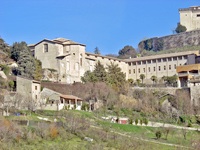
In 1252 Pope Innocent IV approved the move of the Franciscans of Sant’ Elia to this site lower down the Colle di Sant' Elia, which belonged to the Abbazia di San Marco. He also initiated a process of canonisation in respect of the Franciscan Provincial Minister, the Blessed Simone da Collazzone, who died at Sant’ Elia in 1250. This was inconclusive, but the relics of “St” Simon were nevertheless translated with great solemnity to the new church in 1260. The friars’ aspiration for the canonisation of the Blessed Simon was surely behind their decision to include his name saint in the dedication of their new church. (SS Simon and Jude were the last of the twelve Apostles to be appointed by Christ).
The building of the Rocca on the summit of the hill in 1359 heralded a period of great instability for the church and convent. The Rocca was subject to siege on a number of occasions in the 14thand 15th centuries, turning the area below into a battlefield.
-
✴Braccio Fortebracci lodged his soldiers in the convent while he laid siege to the Rocca in 1419. He took the Torre di San Marco (later called the Torre di Baccio) in the outer circuit of the city walls and pounded the fortress for several weeks before he admitted defeat.
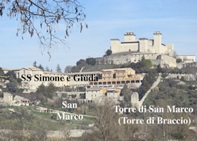
-
✴Things were even worse in the late 1430s, when the people of Spoleto rebelled against Pirro Tomacelli, the hated castellan and confined him to the Rocca. His allies failed to release him and contented themselves with a dreadful sack of the city. The friars seriously considered moving in 1439 but changed their plans in 1440, when Pope Eugenius IV finally regained control of the situation.
When the Blessed Francesco Beccaria died in 1450 at the Convento di San Francesco di Monteluco, Andreola, the mother of Pope Nicholas V, arranged for his funeral to be held with great solemnity in SS Simone e Giuda.
The cult of St Antony of Padua in Spoleto revolved around an image that was believed to be an authentic portrait of the saint: according to tradition, the people of Padua had presented it to Pope Gregory IX when he was in Spoleto for the canonisation in 1232. This image is recorded in a chapel in SS Simone e Guida was dedicated to the saint from the 15th century.
In 1602, St Antony was designated as one of the patron saints of Spoleto at the behest of the friars of SS Simone e Giuda. The cult was reinforced in 1698 when the Princess Olimpia Giustiani Barberini (the wife of Maffeo Barberini, Prince of Palestrina and son of Taddeo, the nephew of Pope Urban VIII) gave a relic of the cranium of St Antony in a precious reliquary to the friars and it was translated with great ceremony to SS Simone e Giuda.
The friars were expelled in the Napoleonic period but managed to return in 1815. An inscription on the facade of the church commemorates the fallen from the last battle that engulfed the area: on the morning of 17th September 1860, Piedmontese soldiers under General Filippo Brignone fired canons on the last remnants of the papal forces in the Rocca.
The complex was finally suppressed in 1863 and adapted for military use. At this point:
-
✴the relics of the Blessed Simone da Collazzone were placed into two urns (the skull in one and the rest of the relics in the other) and taken to the Duomo.
-
✴the venerated image of St Antony of Padua was heavily repainted image passed into private ownership.
The convent was converted for use as an orphanage in 1893. Part of it was demolished in 1950 to make way for a purpose-built structure (seen to the right in the picture at the top of the page).
A few friars managed to remain in Spoleto after the suppression and they finally moved to Sant’ Ansano in 1896. They took the reliquary of St Antony of Padua with them, and they duly changed the dedication of their new church to SS Ansano e Antonio. They tried to return to SS Simone e Giuda in the 1930s, but these moves came to nothing.
Unfortunately, the relic of St Antony was proved to be false in 1981, when the body of the saint at Padua was investigated and found to be complete. In 2000, the relics of the Blessed Simone da Collazzone were translated to Sant’ Ansano.
Architecture
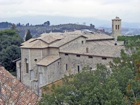
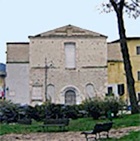
The complex was destroyed beyond redemption when it was transformed into a barracks in 1863.
Art from the Church
Madonna and Child with Franciscan saints (ca. 1450)
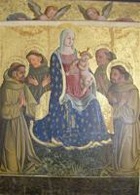
The altarpiece depicts the Madonna and Child with SS Francis, Bernardino of Siena and Antony of Padua and the Blessed Simon (2nd on the left). He is identified by the words “Sanctus Simon” inscribed in his halo despite the fact that he was never canonised.
SS John the Baptist and Peter (1466)
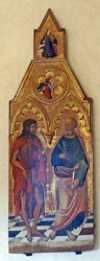
-
✴the Madonna and Child; and
-
✴SS Paul and Francis.
This surviving panel is now in Room 15 of the Museo del Ducato di Spoleto.

